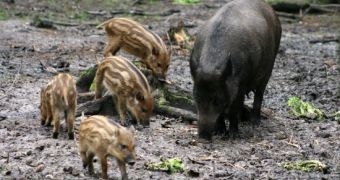More often than not, invasive species turn out to be a hassle, which is why wildlife specialists do their best to monitor them and keep their population well under control.
As previously reported, feral pigs are listed amongst some of the most dangerous invasive species.
However, news from the Brazilian Pantanal says that, since introduced in this region of South American, a species of feral pigs known to specialists as Sus scrofa has actually succeeded in lending a helping hand in terms of safeguarding local wildlife.
Mongabay reports that, several decades ago, the Brazilian Pantanal was nearly left without some of its native species because of a flourishing bush meat trade.
Recreational and commercial hunting also constituted a major threat to local biodiversity, the same source informs us.
It was the introduction of these feral pigs about 200 years ago that allowed local wildlife to make a recovery, simply because people inhabiting this region turned from hunting local species to hunting the pigs.
Specialists explain that the feral pigs now inhabiting the Brazilian Pantanal are relatively easy to find, and also constitute a noteworthy source of meat and fat.
As was to be expected, this makes them rather appealing to hunters in local human communities.
Following their interviewing several hunters in the Brazilian Pantanal, a team of conservationists discovered that 93% of them preferred hunting feral pigs to hunting native species.
In order to make sure the feral pigs do not breed beyond a certain point, locals either neuter young males and then allow them to return to the wild, or target mothers when out hunting.
“Feral pigs are hunted on horseback with dogs. This means that the young are often separated from their mother and will die of hunger or through predation,” Alexine Keuroghlian of the Wildlife Conservation Society, Brazil, says.
By the looks of it, feral pigs were safe to introduce in these ecosystems as a result of their not relying on the same natural resources that local species needed to survive.

 14 DAY TRIAL //
14 DAY TRIAL //